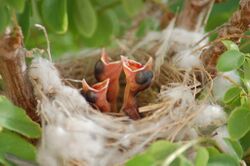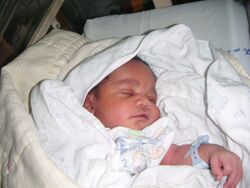Biology:Altriciality
In biology, altricial species are those in which the young are underdeveloped at the time of birth, but with the aid of their parents mature after birth.
The word is derived from the Latin root alere, meaning "to nurse, to rear, or to nourish" and indicates the need for young to be fed and taken care of for a long duration.[1] By contrast, species whose young are immediately or quickly mobile are called precocial.
Scope
In bird and mammal biology, altricial species are those species whose newly hatched or born young are relatively immobile, lack hair or down, are not able to obtain food on their own, and must be cared for by adults; closed eyes are common, though not ubiquitous. Altricial young are born helpless and require care for a length of time. Altricial birds include herons, hawks, woodpeckers, owls, cuckoos and most passerines. Among mammals, marsupials and most rodents are altricial. Domestic cats, dogs, and primates, such as humans, are some of the best-known altricial organisms.[2] For example, newborn domestic cats cannot see, hear, maintain their own body temperature, or gag, and require external stimulation to defecate and urinate.[3] The giant panda is notably the largest placental mammal to have altricial, hairless young upon birth. The larval stage of insect development is considered by some to be a form of altricial development, but it more accurately depicts, especially amongst eusocial animals, an independent phase of development, as the larvae of bees, ants, and many arachnids are completely physically different from their developed forms, and the pre-pupal stages of insect life might be regarded as equivalent to vertebrate embryonic development.
A hastier alternative is employed by precocial animals, in which the young have open eyes, have hair or down, have large brains, and are immediately mobile and somewhat able to flee from, or defend themselves against, predators. For example, with ground-nesting birds such as ducks or turkeys, the young are ready to leave the nest in one or two days. Among mammals, most ungulates are precocial, being able to walk almost immediately after birth. Beyond the precocial are the superprecocial animals, such as the megapode birds, which hatch with full flight feathers.[4] Some ecological niches require young to be precocial for survival, such as cetaceans: restricted to water, and immobile, their helpless young would quickly drown.
Human children, and those of other primates, exemplify a unique combination of altricial and precocial development. Infants are born with minimal eyesight, compact and fleshy bodies, and "fresh" features (thinner skin, small noses and ears, and scarce hair if any). However, this stage is only brief amongst primates; their offspring soon develop stronger bones, grow in spurts, and quickly mature in features. This unique growth pattern allows for the hasty adaptivity of most simians, as anything learned by children in between their infancy and their adolescence is memorized as instinct; this pattern is also in contrast to more prominently altricial mammals, such as many rodents, which remain largely immobile and undeveloped until grown to near the stature of their parents.
Basis
Different animals employ different precocial and altricial strategies; as stated above, some employ elements of both strategies, and as a result the distinction between the two is by some held in question. The skill of the parents to provide care and attend directly to the pre-natal and post-natal development of their young appears to be associated. Precocial birds are able to provide protein-rich eggs and thus their young hatch in the fledgling stage – able to protect themselves from predators and the females have less post-natal involvement. Altricial birds are less able to contribute nutrients in the pre-natal stage; their eggs are smaller and their young still in need of much attention and protection from predators. This may be related to r/K selection; however, this association fails with a number of cases.[5]
In birds, altricial young usually grow faster than precocial young. This is hypothesized to occur so that exposure to predators during the nestling stage of development can be minimized.[6]
In the case of mammals it has been suggested that large, hearty adult body sizes favor production of large, precocious young, which develop with a longer gestation period. Large young may be associated with migratory behavior, extended reproductive period, and reduced litter size. It may be that altricial strategies in mammals, in contrast, develop in species with less migratory and more territorial lifestyles, such as Carnivorans, the mothers of which are capable of bearing a fetus in early stages of development and focusing closely and personally upon its raising, as opposed to precocial animals which provide their youths with a bare minimum of aid and otherwise leave them to instinct.[7]
Terminology
In birds, the terms Aves altrices and Aves precoces were introduced by Carl Jakob Sundevall (1836) and the terms nidifugous and nidicolous by Lorenz Oken in 1816. The two classifications were considered identical in early times, but the meanings are slightly different, in that "altricial" and "precocial" refer to developmental stage, while "nidifugous" and "nidicolous" refer to leaving or staying at the nest.[5]
The two strategies result in different brain sizes of the newborns compared to adults. Precocial animals' brains are fully developed at birth relative to their body size, limiting their knowledge largely to their instincts but providing them immediate access to their bodies. However, as adults, their brains do not develop any further, and they memorize little from birth to death. Altricial animals' brains are comparatively undeveloped at birth, thus their need for care and protection, but their brains immediately begin developing at birth and do so independently, adapting to individual circumstances, and hence as adults, altricial animals attain more versatile brains than their precocial counterparts, capable of strategic thought based on experience. Thus altricial species, ultimately, possess greater potential for skill and adaptability, which is notably a factor in human developmental success.[1]
See also
References
- ↑ 1.0 1.1 Ehrlich, Paul (1988). The Birder's Handbook. New York: Simon & Schuster. ISBN 0-671-65989-8. https://archive.org/details/birdershandbookf00ehrl_0.[page needed]
- ↑ Arterberry, Martha E. (2000). The Cradle of Knowledge. Development of Perception in Infancy. Cambridge: MIT Press. p. 27. ISBN 9780262611527.
- ↑ Hannah Shaw. "Determining a Kitten's Age". http://www.kittenlady.org/age.
- ↑ Starck, J.M.; Ricklefs, R.E. (1998). Avian Growth and Development. Evolution within the altricial precocial spectrum.. New York: Oxford University Press. ISBN 0-19-510608-3.
- ↑ 5.0 5.1 Starck, J. (1998). Avian Growth and Development. Oxford Oxfordshire: Oxford University Press. ISBN 0-19-510608-3.[page needed]
- ↑ Kahl, M. Philip (1962). "Bioenergetics of growth in nestling wood storks". The Condor 64 (3): 169–183. doi:10.2307/1365200. ISSN 0010-5422.
- ↑ Eisenberg, John (1981). The Mammalian Radiations. London: Athlone Press. ISBN 0-485-30008-7.[page needed]
External links



